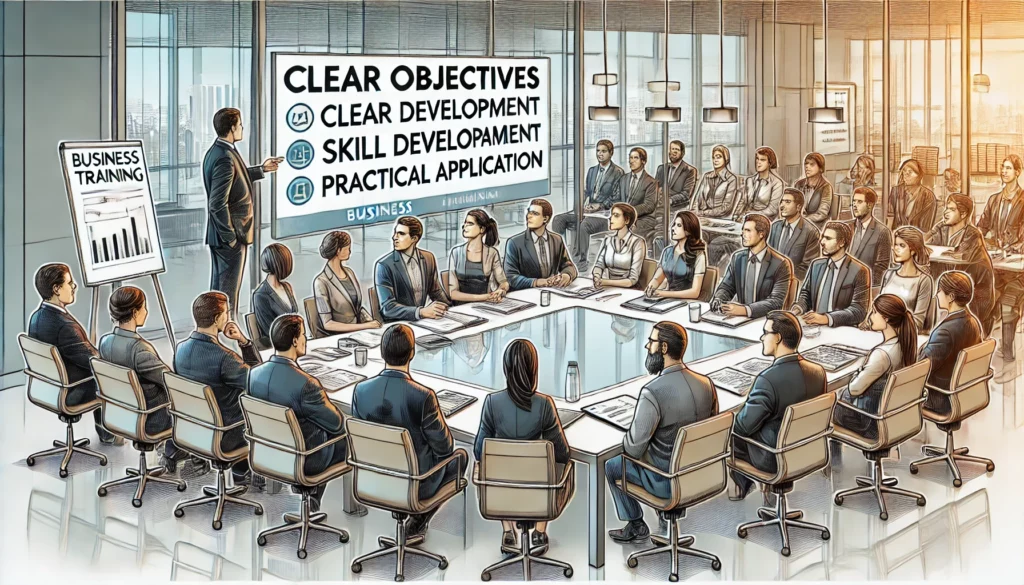Introduction
Developing training programs in the business world requires more than just delivering information; it requires creating a structured learning experience that truly supports employee growth and performance. Yet, one of the most common challenges in employee training is the lack of clearly defined objectives. Without clear objectives and outcomes, training can feel directionless, leaving employees unsure of how to apply what they’ve learned.
When I first began consulting iemployee training, I thought that I only needed to share the most critical information, demonstrate tools, and then test employees to verify understanding. I skimmed over training objectives, assuming that covering the content generally would be sufficient. But I soon realized that to drive real results, I needed to focus on clear, actionable objectives that could guide both me and the employees through each learning experience.
This post will explore how well-defined objectives can transform your training program, making it more engaging, practical, and impactful for employees.
Moving from Information Delivery to Skills Development
In my early days in training hospital staff in safe patient transfers, I assumed that if I presented the information and demonstrated it, employees would retain and apply it. But research consistently shows that, on average, only 5% of information from a lecture is retained after two weeks. Even with demonstrations, retention only climbs to around 30%.
To ensure employees gained practical skills they could apply on the job, I had to rethink my approach and focus on creating active learning experiences. A critical guiding question for me was: How can I help employees gain the skills they need to perform their jobs safely and better?
This shift was a game-changer, transforming my approach from simply presenting information to actively facilitating skill development and creating real-world learning experiences.
Using Objectives to Shape Training
Most businesses have broad goals for training programs, such as improving customer service, enhancing productivity, or increasing efficiency. But without breaking these down into specific objectives, training can feel overwhelming or disconnected from the employee’s role. Objectives serve as a roadmap, outlining what employees should be able to do after training and guiding you in selecting relevant content and methods.
Here’s how objectives can provide structure in real-world business training scenarios.
Example: Customer Service Training
In a customer service training program, objectives might include: The employee will be able to:
- Improving communication and active listening skills
- Learning to handle difficult customer interactions confidently
As nice as these objectives sound, they are vague in their training intentions.
Great training objectives are specific in their conditions and outcomes.
The questions here are “How will you know that they have met the objectives?” and “What do I need to do to help them meet these objectives?”
Beginning with objectives that describe observable behaviors saves time and confusion. Here’s how these objectives look behaviorally.
- By the end of training, employees will demonstrate skilled communication by accurately paraphrasing a customer’s main concerns and confirming understanding in at least 2 role-play scenarios, showing active listening and empathy.
- By the end of training, employees will create a list of 3 specific, effective strategies for managing challenging customer interactions. They will then apply each strategy in role-play scenarios, demonstrating confidence and adaptability in addressing the customer’s concerns.
To achieve these objectives, you might create practical exercises that let employees practice active listening and empathy in role-play scenarios. For the objective “handle difficult interactions,” you could set up a simulated call or in-person interaction, where employees practice techniques in a controlled environment. This approach builds real, applicable skills that employees can use on the job.
The Power of Active Learning Techniques
Once you have defined objectives, the next step is to create active learning experiences that help employees practice and internalize these skills. Here are a few active learning techniques that work well in a business training context and support the development of practical skills.
- Role-Playing: In customer service training, for example, you can set up scenarios with challenging customer interactions. Employees practice responding to these situations and receive feedback, reinforcing key communication skills.
- Hands-On Simulations: If you’re training employees on using new software, hands-on exercises where they apply the software to realistic tasks allow them to gain confidence and proficiency.
- Group Discussions and Problem-Solving: For teamwork and collaboration training, create group exercises where employees work together to solve real business problems, encouraging critical thinking and teamwork.
Example: Sales Training
Consider a sales training program with objectives such as: By the end of this program you will be able to:
- Understanding the product deeply enough to answer customer questions.
- Build rapport and adapting sales techniques to customer needs.
Think about how you might make these objectives and observable.
It may be something like
Original: Demonstrate skilled communication by listening to the customer and paraphrasing their words to increase clarity and demonstrate caring.
Observable Objective:
By the end of training, employees will demonstrate skilled communication by accurately paraphrasing a customer’s main concerns and confirming understanding in at least 2 role-play scenarios, showing active listening and empathy.
Objective 2:
Original: Handle difficult customer interactions confidently by developing 3 different ways you can approach a difficult customer.
Observable Objective:
By the end of training, employees will create a list of 3 specific, effective strategies for managing challenging customer interactions. They will then apply each strategy in role-play scenarios, demonstrating confidence and adaptability in addressing the customer’s concerns.
Notice that the more observable the objective becomes, the more it points to a clear learning experience for the learner, as well as clear evaluation procedures.
For an objective like “understanding the product,” employees might start by studying the product independently and then participate in a Q&A session. To develop rapport-building skills, employees could role-play as both the salesperson and the customer, practicing and refining their approach. This helps them internalize techniques they can apply directly in their sales roles.
Creating Objectives from Scratch
If you need to develop objectives for a training program, start by asking: What do employees need to know, understand, feel and do to excel in their roles? This process can make your objectives clear and actionable. For example, in a project management training course: Below are first draft, then tweaked out into behavioral statements
Knowledge Objective:
Original: Describe standard project management terminology and tools.
Behavioral Objective:
By the end of the training, employees will be able to accurately define and describe at least 10 standard project management terms and explain the purpose of 3 common project management tools in a written or oral quiz.
Understanding Objective:
Original: Given a project, create timelines and manage resources effectively.
Behavioral Objective:
Given a sample project scenario, employees will develop a detailed project timeline and allocate resources efficiently, adjusting the timeline based on specific project constraints in at least two separate case studies.
Attitudes Objective:
Original: Sense of responsibility for quality work.
Behavioral Objective:
By the end of training, employees will demonstrate responsibility for quality work by proactively identifying and addressing potential quality issues in a simulated project review and articulating specific actions they would take to improve quality.
Skills Objective:
Original: Create a project plan and adjust as necessary.
Behavioral Objective:
By the end of training, employees will develop a comprehensive project plan for a given project, and successfully modify the plan in response to at least two changes in project requirements, showing flexibility and problem-solving skills.
These behavioral objectives clearly specify observable, measurable actions that demonstrate employees’ acquisition and application of the necessary knowledge, understanding, attitudes, and skills.
This clarity not only guides the training but also makes it easy to evaluate employee progress.
Engaging Employees in Training
When you build objectives-based training, employees feel more connected to their learning. Here are a few ways to keep them engaged and invested in applying what they learn:
- Emphasize Practical Application: Use case studies, role-playing, and other real-world scenarios that mirror situations employees are likely to face on the job.
- Promote Self-Assessment: Incorporate quizzes, reflection exercises, or checklists to help employees monitor their progress toward each objective.
- Encourage Group Collaboration: Use group discussions or team activities to build a sense of teamwork and reinforce learning. Employees often retain more when they learn collaboratively.
Example: Training for Compliance and Safety
In a compliance and safety program, objectives might include:
- When given a safety situation, demonstrate understanding of company safety procedures and compliance standards
- When given a specific safety hazard, Identify and report safety hazards effectively
For “safety procedures,” a hands-on exercise where employees conduct a mock safety inspection can be highly effective. This allows employees to actively apply their knowledge and become familiar with what to look for in a real environment. For the objective of “reporting hazards,” consider a role-play exercise where employees practice reporting to a supervisor or filling out an incident report. These exercises make learning practical and actionable.
The Reward of Being a Facilitator
When you build training programs that are driven by clear objectives, you’re not only teaching employees—you’re empowering them with skills they can confidently use in their roles. Moving from simply delivering information to facilitating skill development leads to stronger engagement and greater satisfaction as a trainer.
If you’re looking to deepen your expertise and learn more about designing impactful training programs, consider becoming a Certified Facilitator of Adult Learning (CFAL). CFAL offers tools and strategies to help you create structured, competency-based training that resonates with employees and produces measurable results.
Final Thoughts
Are you ready to transform your employee training program? Start by revisiting your training objectives. Ask yourself: How can I make each objective practical and relevant for my team?
With clear objectives, you’re creating a training experience that’s both engaging and actionable, ensuring that employees not only understand the material but know how to apply it on the job.
For more support in building effective training programs, consider CFAL certification, which can provide you with advanced techniques in adult learning and skill-based training. Empower your team and set them up for success in every aspect of their role.



